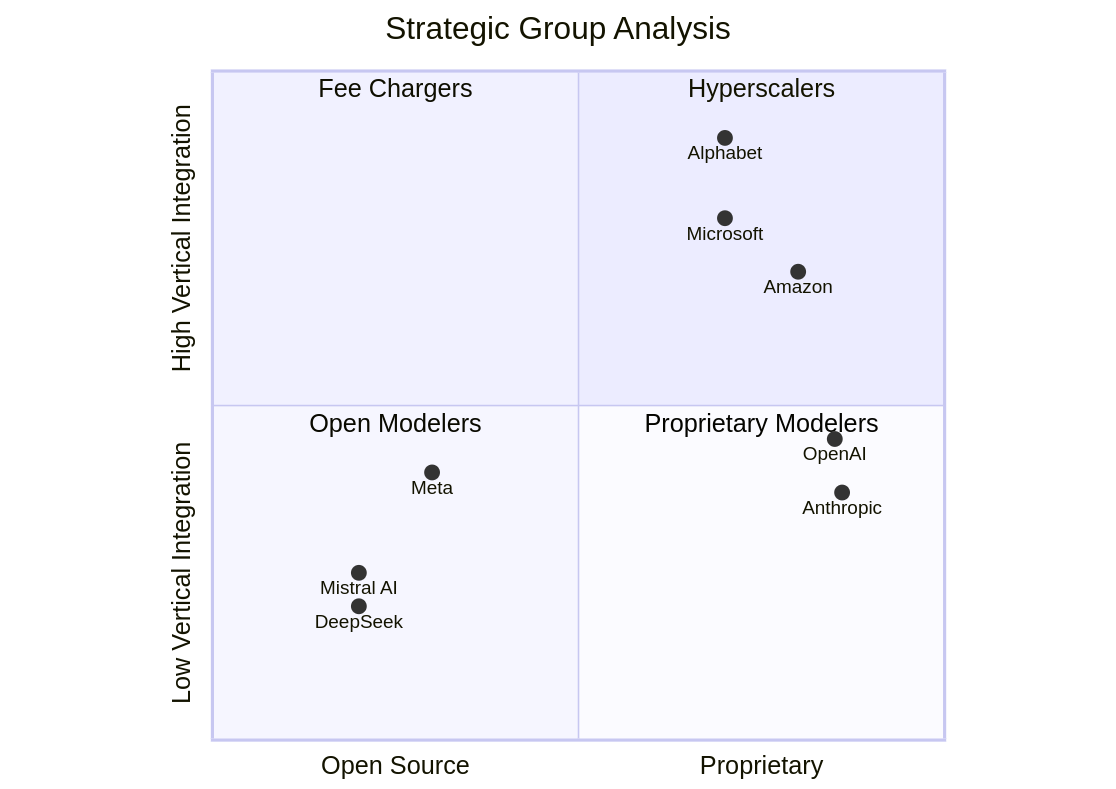Strategic Groups - Analysis

Complex Analysis Activity: Mapping the Generative AI Landscape
This activity challenges you to apply the concept of strategic groups to the generative AI industry. Building on your previous analyses, you will identify and map strategic groups within this dynamic landscape.
Required Preparation
Before starting this activity, make sure you have:
- Completed the “Introduction to Strategy” lesson.
- Completed the “Porter’s Five Forces Analysis” lesson.
- Watched the three assigned videos on the generative AI industry, focusing on the AI business interests of Nvidia, Amazon, and Alphabet.
- Defined the boundaries of the “generative AI industry” in the previous lesson’s Simple Application Activity.
Activity Instructions
-
List Relevant Companies:
Use the content from the videos and research the industry using search or a general-purpose AI assistance such as Gemini, ChatGPT, or Claude. Create a list of companies that operates in the generative AI industry as you defined in the previous lesson’s Simple Application Activity.
-
Identify Key Dimensions:
Based on your understanding of the generative AI industry and the information presented in the videos, identify the key dimensions that differentiate firms within this industry. Consider factors such as:
- Product/service offerings: What types of generative AI products or services do companies offer?
- Target markets: Who are the primary customers for each company’s offerings?
- Technological capabilities: What are the core technologies and innovations that distinguish each company?
- Business models: How do companies generate revenue and create value in the generative AI space?
- Competitive strategies: How do companies compete in this industry? Are they focused on cost leadership, differentiation, or a combination of both?
- Vertical/horizontal integration: What is the scope of company’s economic activities in the generative AI space?
-
Map Strategic Groups:
Using the key dimensions you identified, create a strategic group map to visually represent the competitive landscape of the generative AI industry.
- Select two dimensions that you believe are most critical for distinguishing between strategic groups.
- Plot the companies discussed in the videos (Nvidia, Amazon, Alphabet) on the map, along with any other relevant competitors you’ve identified.
- Consider the size of the circles representing each company to reflect their market share or other relevant metrics (Optional).
-
Analyze and Interpret:
Analyze the strategic group map you’ve created. Consider the following questions:
- How many distinct strategic groups can you identify?
- What are the key characteristics of each group?
- How do the different groups compete with each other?
- Are there any “blue ocean” opportunities in the market?
- How might the competitive landscape evolve in the future? Do you foresee new entrants?
- Analyze the insights you generated from five forces and PESTLE lessons using strategic groups. Does the impact of five forces vary across strategic groups? How about the impact of the PESTLE factors?
-
Reflection:
Reflect on your analysis and consider the following questions:
- How did the process of identifying and mapping strategic groups deepen your understanding of the generative AI industry?
- What insights did you gain about the competitive dynamics and potential opportunities in this industry?
- How can companies use strategic group analysis to inform their strategic decision-making?
Sharing Your Insights (Optional)
While this activity is designed for individual analysis and reflection, consider sharing your insights with others. You could:
- Discuss your analysis with a classmate or colleague.
- Post your key takeaways on a relevant online forum or discussion board.
- Write a blog post or article summarizing your analysis and insights.
By actively engaging with this complex analysis, you’ll deepen your understanding of strategic group analysis and develop your ability to apply it to real-world situations.